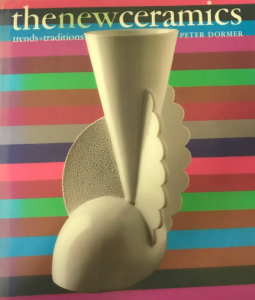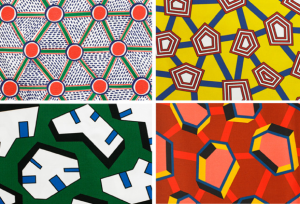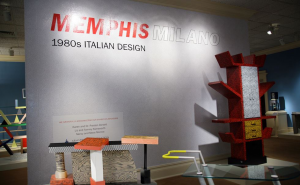Dormer, P. (1986). The New Ceramics. London: Thames and Hudson.
I started this task looking into different pottery designs focusing on a book, by Peter Dormer, that explores new trends as well as traditions under the umbrella of ceramics. Two pieces that particularly caught my eye were by the artist Matteo Thun labelled ‘Cocktail glass’ and ‘Flower vase’ – both of which were produced in Italy around the time of 1982. The reason these ceramics caught my eye in particular was because they seemed to break up my stereotypical view and thoughts on pottery being circular, round and smooth in appearance but instead these designs consisted of much more abstract and harsh shapes that were fixed together at a central point. The lack of colour in these pieces allowed the more daring shapes to be the focal point and permitted shadows to be easily seen which added to the various dimensions of these designs. The subtle addition of slight texture meant that the sections of the designs could be broken up showing the different shapes that were used to create the final resulting design.
Merrill Lyons. (2017). Nathalie Du Pasquier. [online] Available at: http://merrilllyons.com/nubert-says/2014/2/1/nathalie-du-pascalier [Accessed 5 Nov. 2017].
Following my previous research I decided to look into designers that shared Matteo Thun’s use of abstract and bold shapes which led me to the artist Nathalie du Pasquier. In her work she uses a wide use of texture, colour and unique shapes to produce captivating designs that usually turn out to be statement interior pieces. Nathalie liked to oppose the conventional norm challenging what most perceived as good taste to try and break most people’s perception of what art and pattern for interiors should look like – she once stated “Form didn’t have to follow function, a telephone could have the shape of a banana”. Due to my current rotation being print I would like to get across this idea of bold shapes in my own work, deconstructing the outlined shapes of the ceramics to make them into interesting printed designs.
Design Museum. (2017). Memphis. [online] Available at: https://designmuseum.org/memphis [Accessed 5 Nov. 2017].
With further research I discovered that Nathalie du Pasquier was part of the Memphis art movement that occurred in the 80’s. The Memphis ground was founded in Milan by Ettore Sottsass in 1981 and their focus was to design and create designs ranging from postmodern furniture to ceramics that conflicted the usual designs at the time from 1981 to 1987. There was an exhibition at the Design Museum, 13 April – 13 July 2014, that showcased this work and has influenced designers work since and therefore is still a big part of the design world today. For example in 2011 Christian Dior showcased aspects of this movement in the fall collection with features such as bold prints with overlaying embroidery topped off with statement geographical shapes used for the headpieces.



